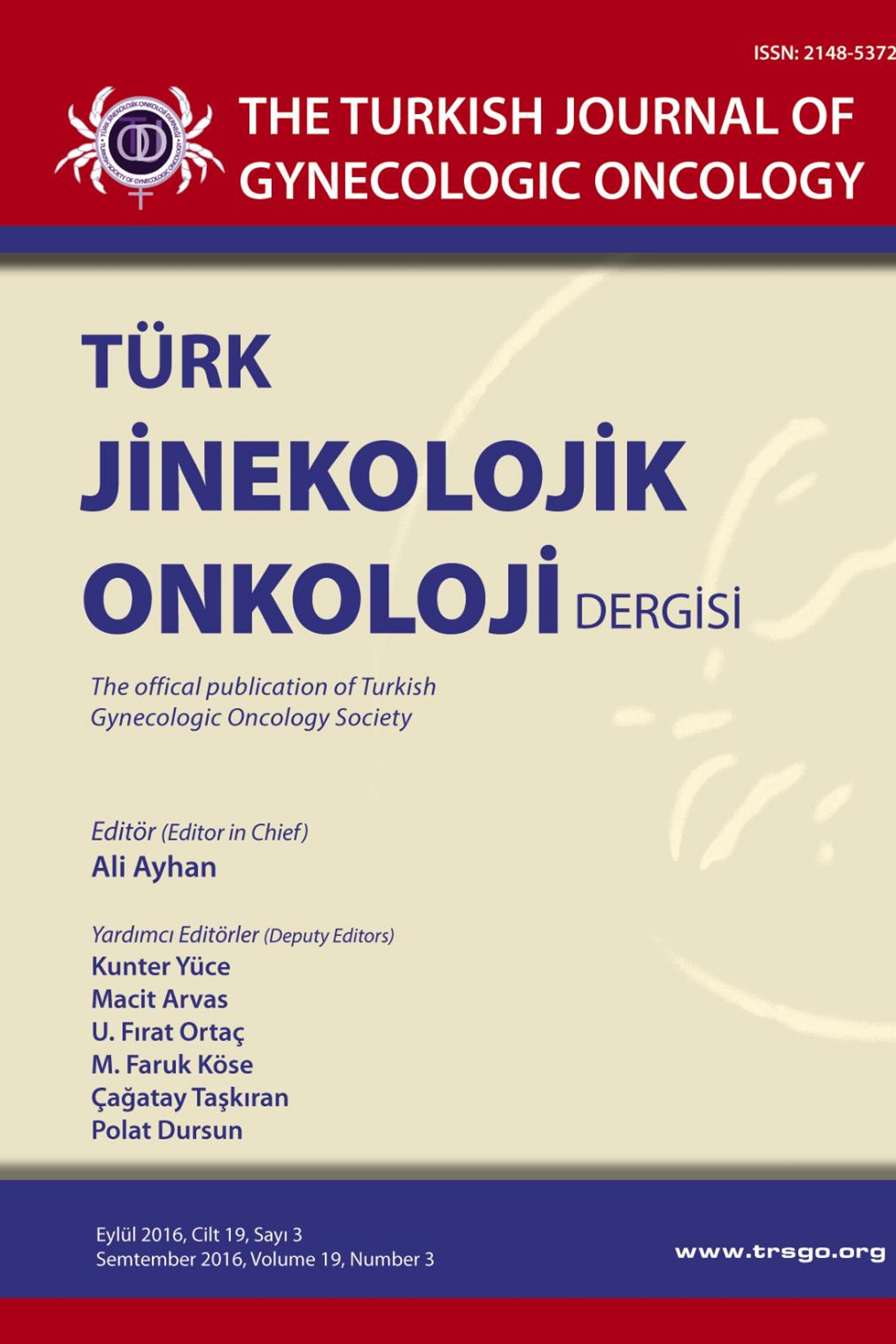Epitelyal Over Kanserinde Retroperitoneal Lenf Nodu Metastazı Etkileyen Faktörlerin Araştırılması
Over kanseri, lenf nodları, metastaz
The Investigation of The Factors Affecting Retroperitoneal Lymph Node Metastasis In Epithelial Ovarian Cancer
Ovarian cancer, Lymph node, Metastasis,
___
- 1. Ayhan A. Epiteliyal over kanserleri. Jinekolojik Onkoloji 2002. p. 133.
- 2. DeSantis CE, Lin CC, Mariotto AB, Siegel RL, Stein KD, Kramer JL, et al. Cancer treatment and survivorship statistics, 2014. CA: a cancer journal for clinicians2014;64:252-71.
- 3. Quirk JT, Natarajan N. Ovarian cancer incidence in the United States, 1992-1999. Gynecologic oncology2005;97:519-23.
- 4. Smith EM, Anderson B. The effects of symptoms and delay in seeking diagnosis on stage of disease at diagnosis among women with cancers of the ovary. Cancer1985;56:2727-32.
- 5. Yancik R, Ries LG, Yates JW. Ovarian cancer in the elderly: an analysis of Surveillance, Epidemiology, and End Results Program data. American journal of obstetrics and gynecology1986;154:639-47.
- 6. Zhang M, Lee AH, Binns CW. Reproductive and dietary risk factors for epithelial ovarian cancer in China. Gynecologic oncology2004;92:320-6.
- 7. Fathalla MF. Incessant ovulation--a factor in ovarian neoplasia? Lancet1971;2:163.
- 8. Vine MF, Calingaert B, Berchuck A, Schildkraut JM. Characterization of prediagnostic symptoms among primary epithelial ovarian cancer cases and controls. Gynecologic oncology2003;90:75-82.
- 9. Olson SH, Mignone L, Nakraseive C, Caputo TA, Barakat RR, Harlap S. Symptoms of ovarian cancer. Obstetrics and gynecology2001;98:212-7.
- 10. Levi F, Franceschi S, La Vecchia C, Ruzicka J, Gloor E, Randimbison L. Epidemiologic pathology of ovarian cancer from the Vaud Cancer Registry, Switzerland. Annals of oncology : official journal of the European Society for Medical Oncology1993;4:289-94.
- 11. Katsube Y, Berg JW, Silverberg SG. Epidemiologic pathology of ovarian tumors: a histopathologic review of primary ovarian neoplasms diagnosed in the Denver Standard Metropolitan Statistical Area, 1 July-31 December 1969 and 1 July-31 December 1979. International journal of gynecological pathology : official journal of the International Society of Gynecological Pathologists1982;1:3-16.
- 12. Bast RC, Jr., Klug TL, St John E, Jenison E, Niloff JM, Lazarus H, et al. A radioimmunoassay using a monoclonal antibody to monitor the course of epithelial ovarian cancer. The New England journal of medicine1983;309:883-7.
- 13. Saygili U, Guclu S, Uslu T, Erten O, Demir N, Onvural A. Can serum CA-125 levels predict the optimal primary cytoreduction in patients with advanced ovarian carcinoma? Gynecologic oncology2002;86:57-61.
- 14. Chi DS, Venkatraman ES, Masson V, Hoskins WJ. The ability of preoperative serum CA-125 to predict optimal primary tumor cytoreduction in stage III epithelial ovarian carcinoma. Gynecologic oncology2000;77:227-31.
- 15. Kamura T, Jeon JD. Lymph node metastasis in a gynecologic malignancy. Yonsei medical journal2002;43:783-91.
- 16. Merino MJ, Jaffe G. Age contrast in ovarian pathology. Cancer1993;71:537-44.
- 17. Bidzinski M, Radziszewski J, Panek G, Danska-Bidzinska A. [Risk of lymph node metastases in patients with ovarian cancer]. Ginekologia polska2003;74:671-6.
- 18. Chen SS, Lee L. Incidence of para-aortic and pelvic lymph node metastases in epithelial carcinoma of the ovary. Gynecologic oncology1983;16:95-100.
- 19. Tsuruchi N, Kamura T, Tsukamoto N, Akazawa K, Saito T, Kaku T, et al. Relationship between para-aortic lymph node involvement and intraperitoneal spread in patients with ovarian cancer--a multivariate analysis. Gynecologic oncology1993;49:51-5
- ISSN: 2148-5372
- Başlangıç: 2014
- Yayıncı: Türk Jinekolojik Onkoloji Derneği
Uterin Kama Rezeksiyonu ile Tedavi Edilen Overin Seks Kord Tümörüne Benzeyen Uterin Tümör Vakası
Duygu Altın, Salih TAŞKIN, Fırat Ortaç
Gestasyonel Trofoblastik Hastalıklarda Histerektominin Rolü
Pınar Çağlar AYTAÇ, Ülkü Mete VURAL, Tayfun GÖNGÖR
Adenomyozis Odağından Kaynaklanan Uterusun Adenofibromu: Oldukça Nadir Bir Lokalizasyon
Pembe Oltulu, Kazım Gezginç, Gülşah Orkan
Epitelyal Over Kanserinde Retroperitoneal Lenf Nodu Metastazı Etkileyen Faktörlerin Araştırılması
